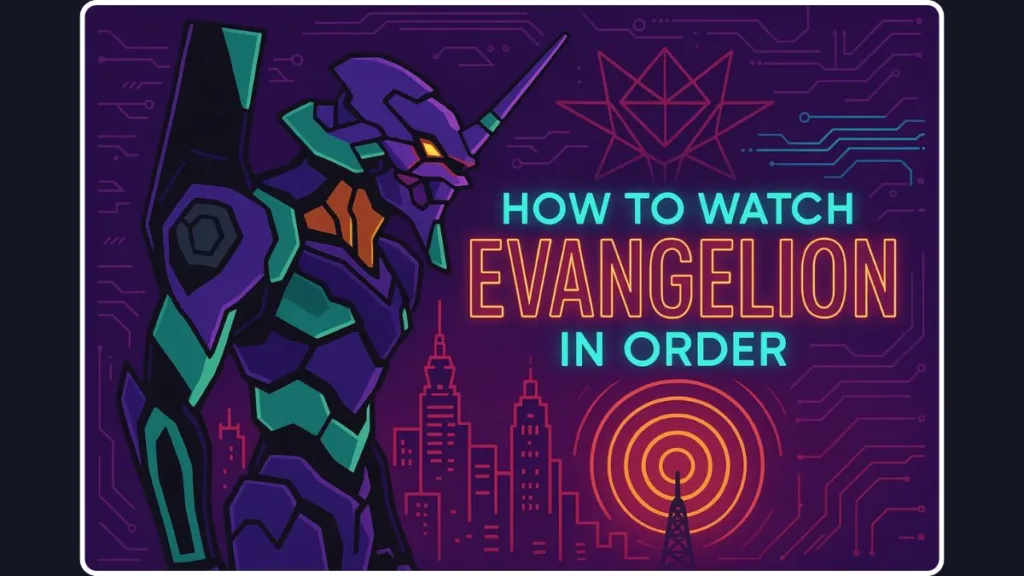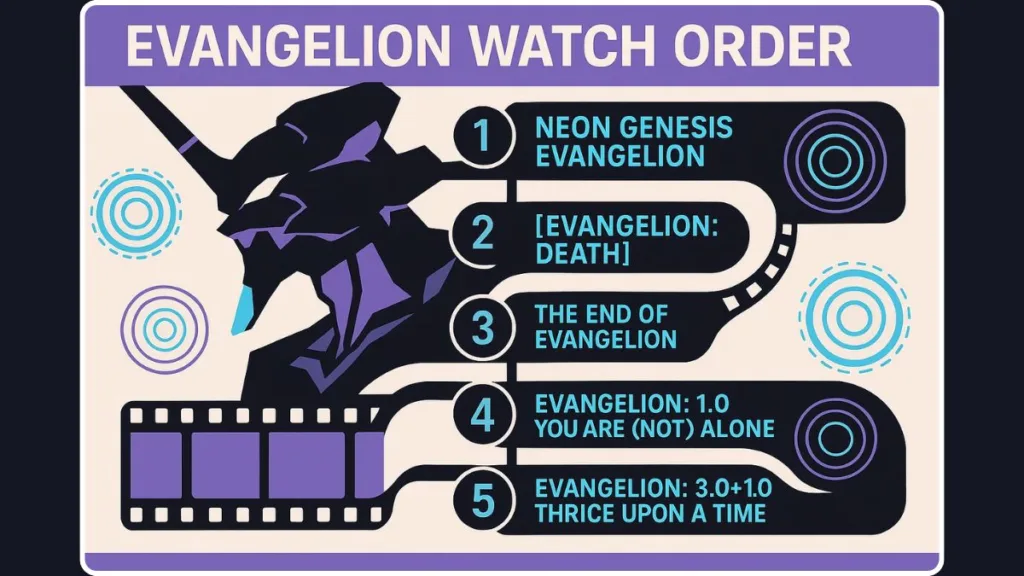Confused about the Evangelion timeline? Learn exactly how to watch Evangelion in order in 2025 with this complete guide. With the correct viewing sequence of the series, movies, and Rebuild films. Perfect for first-time viewers and returning fans.
Welcome to one of the most brilliant and famously confusing anime franchises ever made.
If you’ve ever tried to figure out the Evangelion watch order, you already know how tangled things can get—multiple endings, recap films that feel essential but aren’t, and reboot movies that begin as simple remakes and then explode into an entirely new timeline full of twists, divergences, and emotional depth.
This confusion is completely normal because Evangelion spans multiple formats, released over decades, each with a different purpose. The franchise includes a foundational series, alternate interpretations, recap materials, and a reimagined film saga. For many first-time viewers, the structure feels overwhelming before they even watch a single episode.

Take a breath—you’re not alone.
This guide is here to break down everything clearly so you can enjoy Neon Genesis Evangelion the way it was meant to be experienced, without stress, spoilers, or wasted time.
Whether you’re a complete beginner stepping into Tokyo-3 for the first time or a returning fan looking for clarity, this structure gives you a smooth, chronological, and emotionally coherent path through one of anime’s most legendary stories.
Let’s make this easy.
Best Evangelion Watch Order for First-Time Viewers
If you want the best, cleanest, and most beginner-friendly experience with zero confusion, follow this order:
- Neon Genesis Evangelion (Episodes 1–26)
- The End of Evangelion (1997)
- Rebuild of Evangelion Movies:
- Evangelion: 1.11 You Are (Not) Alone
- Evangelion: 2.22 You Can (Not) Advance
- Evangelion: 3.33 You Can (Not) Redo
- Evangelion: 3.0+1.01 Thrice Upon a Time
This order ensures you experience the story exactly as intended, feel the narrative shift when it hits hardest, and get the full emotional weight of the original ending before diving into the bold new reality of the Rebuild films.
You also get the chance to see how Evangelion evolved across generations—from its mid-90s stylistic grit to its modern cinematic polish. This viewing order reflects the creative progression of the franchise and the thematic journey Hideaki Anno wanted audiences to experience.
Why the Release Order Is the Best Evangelion Viewing Experience
Evangelion is not just a series—it’s an experience, a journey into psychology, mythology, identity, and the human condition.
Watching in release order ensures:
- You get the story as Hideaki Anno originally envisioned it
- You feel the emotional escalation in the correct sequence
- You avoid major Rebuild spoilers, which rely on your knowledge of the TV series
- You understand why The End of Evangelion exists, and why fans call it the “true ending”
- You appreciate how the Rebuild timeline diverges only after grounding you in the original world
Evangelion’s emotional build-up is constructed deliberately. The original series sets up a world filled with mystery, metaphor, and internal conflict, while the film endings dive deeper into the psychological chaos behind the scenes.
The original series also suffered from budget constraints that shaped its final episodes—information that becomes incredibly important once you see how The End of Evangelion responds to those limitations.
Meanwhile, the Rebuild films were created years later using modern animation and storytelling techniques, giving you a fresh perspective after you’ve experienced the classic story.
Watching in this order preserves the emotional pacing, thematic layering, and intended shock value of the franchise.
Neon Genesis Evangelion (Episodes 1–26): What the Original Series Covers
This 26-episode anime from 1995–96 is where everything begins.
It opens like a stylish mecha adventure and gradually transforms into a psychological, philosophical, and emotionally raw exploration of trauma, fear, identity, and acceptance.
Its shift from action to introspection is part of what made Evangelion a cultural turning point. No anime before it blended mental health, existential crisis, and symbolic storytelling in such a bold way.
Key Details About the Original Series
- Episodes 1–24 cover the main narrative involving the Angels, NERV, the EVA Units, and their young pilots.
- Episodes 25–26 shift into a surreal, introspective, highly symbolic ending that dives into the characters’ inner thoughts, repressed feelings, and subconscious fears.
- The show is layered with religious symbolism, philosophical references, psychological frameworks, and an atmosphere of constant tension and vulnerability.
- Every main character—Shinji, Asuka, Rei, Misato, Gendo—carries heavy emotional baggage, and the series explores how each of them navigates grief, trauma, and connection.
- The TV ending is beloved by some for its internal focus and thematic richness, while others struggled with its abstract presentation.
This is why The End of Evangelion exists.
Above all, this is the foundation.
Everything else—the movies, theories, timeline branches—comes from experiencing this core series first.
The original series also introduced visual elements that became legendary: the AT Field, the LCL fluid, the geometric Angel designs, and Shinji’s iconic EVA-01. These form the backbone of the Evangelion universe.
The End of Evangelion Explained: Why This Is the True Final Ending
If the TV ending left you confused—or wanting more closure—this movie is your answer.
Released in 1997, The End of Evangelion replaces Episodes 25–26 with a complete alternate ending that shows the external events surrounding the climax of the series.
It’s widely considered one of the greatest animated films ever created. Its haunting imagery, philosophical depth, and emotional brutality leave a lasting impression on viewers.
Why The End of Evangelion Is Essential
- It provides the full, conclusive version of the original story
- It showcases some of the most iconic, disturbing, and beautiful animation ever produced
- It reveals the true nature of Third Impact, the Human Instrumentality Project, and Shinji’s final choice
- It presents character fates and motivations with dramatic clarity
- It serves as creator Hideaki Anno’s direct response to the limitations and reception of the TV ending
The End of Evangelion is emotionally heavy, visually intense, and thematically dense.
It’s one of the most discussed anime films ever made—and for good reason.
Its final sequences, particularly the ending set on the beach, have been analyzed for decades and continue to inspire theories, academic research, and creative interpretations across the world.
Evangelion: Death(True)²: Should You Skip This Recap Film?
Short answer: You can skip it.
Why It’s Not Required
- Death(True)² is largely a recap film summarizing the first 24 episodes.
- It includes a few new or re-edited scenes, but these have already been incorporated into the Director’s Cut versions of Episodes 21–24.
- It doesn’t add new story elements needed to understand The End of Evangelion.
- It’s mainly useful for people who want a fast refresher.
If your goal is a clean, confusion-free watch order, you won’t miss anything important by skipping it.
This film exists because Evangelion was immensely popular in the late 90s, and studios often produced recap movies to prepare audiences for major theatrical releases.

Rebuild of Evangelion Movies: How the Remake Timeline Works
Once you’ve watched the TV series and The End of Evangelion, you’re ready for the next phase: the Rebuild films.
These movies begin as a remake, evolve into a reinterpretation, and ultimately form a new timeline.
The Rebuild project allowed Anno and Studio Khara to revisit Evangelion with modern animation technology, updated character arcs, and new philosophical angles.
Evangelion: 1.11 — You Are (Not) Alone
- A polished, modernized retelling of the first episodes of the series
- Upgraded visuals and smoother pacing
- Mostly faithful — but with hints of upcoming divergence
This film sets the tone for the new timeline, offering enhanced versions of classic scenes like the fight against Sachiel and the introductions to Rei and Misato.
Evangelion: 2.22 — You Can (Not) Advance
- Significant story deviations begin
- Mari Illustrious Makinami is introduced
- Reimagined Angel battles
- Dramatic, game-changing ending
This film’s emotional core comes from its radical reinterpretation of characters like Asuka, Rei, and Shinji. It expands the world, deepens the lore, and injects a bold new energy.
Evangelion: 3.33 — You Can (Not) Redo
- A shocking 14-year timeskip
- Characters have drastically changed
- World-building shifts dramatically
- Intentionally confusing, mirroring Shinji’s perspective
This film breaks expectations intentionally. It forces viewers to confront uncertainty, mirroring Shinji’s disorientation after years of missing context.
Evangelion: 3.0+1.01 — Thrice Upon a Time
- The final conclusion to the Rebuild saga
- Emotional closure for Shinji and the franchise
- Mixes introspection, massive battles, symbolism, and meta themes
- Surprisingly hopeful, deeply emotional ending
It is the most mature movie in the franchise, giving Shinji Ikari a level of emotional growth and self-awareness that completes his journey across all timelines.
Evangelion Chronological Order (For Rewatchers Only)
Some fans enjoy a chronological approach, but it’s not recommended for beginners.
Chronological Order Layout
- Neon Genesis Evangelion Episodes 1–24
- Evangelion: Death(True)² (Optional)
- First half of The End of Evangelion
- Episodes 25–26
- Second half of The End of Evangelion
- Rebuild films (1.11 → 2.22 → 3.33 → 3.0+1.01)
This approach is ideal for analyzing the story’s emotional rhythm, contrasting endings, and visual symbolism.
Where to Watch the Entire Evangelion Franchise
Everything is available on major platforms.
Netflix
Note: Netflix uses a newer English dub and does not include “Fly Me to the Moon.”
Amazon Prime Video
Together, Netflix and Prime Video provide a complete, easy-to-access viewing experience.
Evangelion Watch Order Summary Table
| Title | Type | Essential? | Watch Order | Stream On |
|---|---|---|---|---|
| Neon Genesis Evangelion (1–26) | TV Series | Yes | 1 | Netflix |
| The End of Evangelion | Movie | Yes | 2 | Netflix |
| Evangelion: 1.11 | Rebuild | Yes | 3 | Prime Video |
| Evangelion: 2.22 | Rebuild | Yes | 4 | Prime Video |
| Evangelion: 3.33 | Rebuild | Yes | 5 | Prime Video |
| Evangelion: 3.0+1.01 | Rebuild | Yes | 6 | Prime Video |
| Death(True)² | Recap Film | Optional | After Ep. 24 | Netflix |
Frequently Asked Questions About Evangelion Watch Order
Should I watch Neon Genesis Evangelion or the Rebuild movies first?
Always watch the original series first.
Is The End of Evangelion the true ending?
Yes, it is the complete cinematic ending.
Can I skip Evangelion: Death(True)²?
Yes, it’s optional.
Difference between 1.0 and 1.11 (and 2.0 vs 2.22)?
“.11” and “.22” are enhanced home releases with extra scenes and improved visuals.
Do the Rebuild movies replace the original?
No. They become a new timeline.
Conclusion: Start Your Evangelion Journey Confidently
You’re now fully equipped to dive into one of the most iconic—and conversation-starting—anime experiences ever created.
Evangelion can be overwhelming at first glance, but with the right watch order, it becomes a powerful, unforgettable journey through emotion, identity, and the end of the world.
Follow the steps above, relax, and enjoy the ride.
Visit Our Post Page: Blog Page
